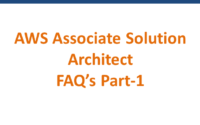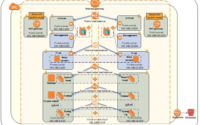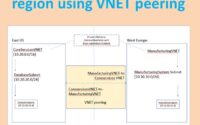Azure AZ-900 Exam Study Notes Part – 1
AZ-900 exam is an opportunity to prove knowledge of cloud concepts, services, pricing, SLA, and lifecycle, and the fundamentals of cloud security, privacy, compliance, and trust. This “Azure AZ-900 Exam Study Notes Part – 1” blog series covers some of the questions and answers used for brainstorming and self-learning. This is a part-1 of the series, the remaining question and answer notes will follow in the upcoming posts
Also, Please note following skills are measured part of the exam.
- Cloud concepts (15-20%)
- Core Azure services (30-35%)
- Security, privacy, compliance, and trust (25-30%)
- Azure pricing Service Level Agreements, and Lifecycles (20-25%)
AZ-900 Exam Study Notes – Part 1
| 1 | What is the benefit of the Azure CDN? |
| A | The Content Delivery Network (or CDN) in Azure can be used to reduce load times and bandwidth as well as speed up responsiveness. |
| 2 | What is Azure Virtual Network? |
| A | Azure Virtual Network enables Azure resources like Virtual Machines to securely communicate with each other, with the Internet and with on-site networks. Importantly, it lets you implement multiple virtual networks, as well as a filter or even route network traffic. |
| 3 | What Is Azure Active Directory? |
| A | Azure Active Directory is an Identity and Access Management system. Furthermore, it lets you grant employee access to specific products and services |
| 4 | What is a PowerShell cmdlet? |
| A | A small lightweight command to perform an action. Cmdlets make up the majority of Azure features for PowerShell. This makes it easier to be consistent and efficient when interacting with Azure resources. Also, PowerShell works with many different services in Windows. |
| 5 | What are the two types of scaling on Azure? |
| A | Scaling up or down, and scaling out. Scaling up and down is making a resource, such as a VM, larger or smaller. Additionally, Scaling out is adding more resources of the same type. |
| 6 | How does scalability on Azure work? |
| A | As resource demand increases, Azure can split the demand over more resources and scale the application. Scalability allows any application to add resources almost instantly as demand increases. Notably, scalability is not working across regions, but rather within the same application. |
| 7 | Explain HdInsight. |
| A | Azure HDInsight is a cloud service that makes it easy, fast, and cost-effective to process massive amounts of data. It uses open-source frameworks like Hadoop, Spark, Hive, LLAP, Kafka, Storm, and R. Moreover, HDInsight can enable a broad range of scenarios, including ETL, data warehousing, and Machine Learning, etc. |
| 8 | What are the advantages of the Azure Resource Manager? |
| A | Azure Resource Manager enables users to manage their usage of application resources. |
| 9 | What is the Federation in Azure SQL? |
| A | It provides tools that can enable developers to access or share databases among themselves in SQL Azure. |
| 10 | What are the different types of storage offered by Azure? |
| A | Azure Blob Storage, Azure Table Storage, Azure File Storage & Azure Queue Storage |
| 11 | What is an Azure region? |
| A | A set of datacenters close together. Azure regions used correctly can create a more robust and better-performing application. Importantly, regions are not a geographic distinction necessarily, but a more loose definition. It has to do with hardware and enables high availability and elasticity. |
| 12 | What is the purpose of the Resource Manager in Azure? |
| A | Any creation, updating, or deleting of Azure resources is done by the Azure Resource Manager. It is the common architectural layer which all commands must go through to interact with Azure resources. Furthermore, the RM manages all resources on Azure and is the only tool that creates resources on Azure. |
| 13 | What is significant about resource groups in Azure? |
| A | They aren’t resources, but all resources must be in one. And resources belong to a resource group, which can be a logical, geographical, customer-specific, or any other type of grouping. RG can contain any kind of resources from Azure, and resources have some data, which describes the resource group itself. Additionally, resource groups cannot be moved between regions. |
| 14 | Why would you use the Azure Cloud Shell instead of the Azure CLI or PowerShell? |
| A | The Cloud Shell can be used entirely in a web browser and can be used across multiple devices. |
| 15 | What is a good reason to use the Azure CLI? |
| A | The Azure CLI is all text-based, thus there is no user interface to change. Certainly, this means that the commands and procedures stay very static in the tool. You can use all products and services with the CLI. |
| 16 | Which Azure products and services are available through the Azure Portal? |
| A | You can access all generally available Azure products and services through the Azure Portal with any type of subscription. However, some services in preview may not be available just yet. |
| 17 | What is “serverless” computing? |
| A | It is serverless when all servers for a solution are abstracted away and managed by someone else. Therefore, serverless computing solutions provide a simple way to create manageable and scalable solutions at low costs. Obviously, there is always a server somewhere to run your application, but you don’t control it |
| 18 | What is consumption-based pricing on Azure? |
| A | Consumption-based pricing is one way to get the best value out of Azure if the usage is not time-based. For instance, consumption-based pricing is not limited to free accounts, and the services are not necessarily consumed all the time. |
| 19 | What is an availability zone? |
| A | One or more datacenters equipped with independent power, cooling, and networking. Also, availability zones can ensure that your Azure application can handle outages and hardware failures. It can be a set of data centers, but often availability zones are within the same datacenter too |
| 20 | When can you remove a resource group from Azure? |
| A | At any time. When a resource group is removed or deleted, all of the resources within it are deleted with it. In short, you can remove resource groups at any time. |
Summary & Next Steps
For passing the exam, on top of this blog series, I strongly urge you to create an account in the Azure portal and get some real-time experience on the topic. For more information, please visit Microsoft sites AZ-900 and Azure fundamentals. Also” Azure AZ-900 Exam Study Notes Part – 2” in case if you missed the part-1 of the study notes. Happy learning


